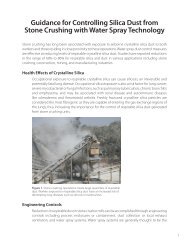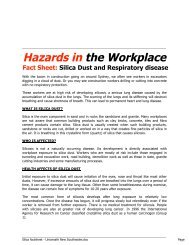Safety & Health in the Stone Crushing Industry - Occupational ...
Safety & Health in the Stone Crushing Industry - Occupational ...
Safety & Health in the Stone Crushing Industry - Occupational ...
You also want an ePaper? Increase the reach of your titles
YUMPU automatically turns print PDFs into web optimized ePapers that Google loves.
14<br />
Step 5 Review your risk assessment and update if necessary<br />
Few workplaces stay <strong>the</strong> same. Eventually, you will br<strong>in</strong>g <strong>in</strong> new equipment, change procedures or<br />
simply shift to ano<strong>the</strong>r place. This can lead to new hazards. It makes sense, <strong>the</strong>refore, to take time to<br />
review <strong>the</strong> situation on an ongo<strong>in</strong>g basis. Every year, you should review how th<strong>in</strong>gs are, where <strong>the</strong>re is<br />
room for improvements and if your former improvements are still work<strong>in</strong>g.<br />
Look at your risk assessment aga<strong>in</strong>: Have <strong>the</strong>re been any changes? Are <strong>the</strong>re improvements you still<br />
need to make? Have your workers spotted a problem? Can you learn anyth<strong>in</strong>g from accidents or near<br />
misses? It is best to th<strong>in</strong>k about this risk assessment while you are plann<strong>in</strong>g your change – that way<br />
you are ahead of any surprises. If <strong>the</strong>re is a significant change dur<strong>in</strong>g <strong>the</strong> year, do not wait. Just look at<br />
your risk assessment and, where necessary, correct it. The benefits of plann<strong>in</strong>g are enormous.<br />
Prevent<strong>in</strong>g just one accident is usually three or four times cheaper than pay<strong>in</strong>g for <strong>the</strong> subsequent cost<br />
of an accident.<br />
You will f<strong>in</strong>d more <strong>in</strong>formation on hazards and risks at work at <strong>the</strong>se<br />
websites:<br />
http://www.osha.gov<br />
http://www.hse.co.uk<br />
http://www.cdc.gov/niosh/homepage.html<br />
http://www.ccohs.ca/<br />
A.2 Prevent<strong>in</strong>g Accidents <strong>in</strong> a <strong>Stone</strong> Crush<strong>in</strong>g Unit<br />
A.2.1 Prevent<strong>in</strong>g Falls from Heights<br />
Accidents are always bad for <strong>the</strong> victim and for bus<strong>in</strong>ess. Some of <strong>the</strong> most common causes of<br />
accidents <strong>in</strong> a stone crush<strong>in</strong>g unit are:<br />
−<br />
−<br />
−<br />
Hands and f<strong>in</strong>gers or toes be<strong>in</strong>g crushed by stones<br />
Body parts such as hands or arms be<strong>in</strong>g caught <strong>in</strong> mach<strong>in</strong>es<br />
Traffic accidents <strong>in</strong>side <strong>the</strong> unit<br />
− Fall<strong>in</strong>g and slipp<strong>in</strong>g from heights<br />
There are many occasions where stone crush<strong>in</strong>g workers are at a specific risk for falls.<br />
Location/Workplace<br />
−<br />
−<br />
−<br />
Work<strong>in</strong>g on top of <strong>the</strong> primary crusher, for <strong>in</strong>stance dur<strong>in</strong>g boulder off load<strong>in</strong>g when boulders are<br />
brought <strong>in</strong> by trailers from quarries and fed <strong>in</strong> to <strong>the</strong> receiv<strong>in</strong>g pit<br />
At <strong>the</strong> primary crusher area when stones are stuck and need to be shoved to undo <strong>the</strong> jam<br />
On work platforms, for <strong>in</strong>stance dur<strong>in</strong>g repair and ma<strong>in</strong>tenance work on <strong>the</strong> crusher itself







